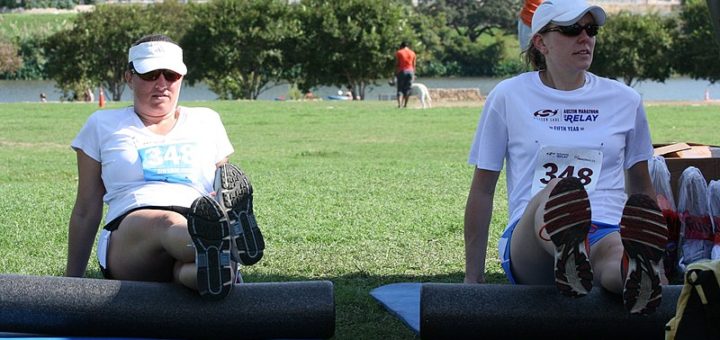Foam rolling is a new method that is especially effective in treating and improving simply as well as blood circulation in the muscles, especially in seniors.
Foam rolling exercise for seniors has grown quite popular, and there are so many benefits that they can gain from the exercises.
Foam Roller exercises are mainly a form of massage for stiff, sore, and tight muscles, which improves their elasticity and helps to get rid of tension and knots in your muscles.
For seniors, Foam Roller Exercises can be particularly healthy and beneficial in the long run.

Table of Contents
Benefits of Foam Roller Exercises for Seniors
Many people may need to learn exactly what a foam roller is or how to use it. However, in this article, we will explain it all and add a video you can follow.
Well, if that makes it easier, a foam roller looks like a shorter and much thicker version of a pool noodle. It is a large roll of foam used for massaging and rolling-type exercises, also called Self-Myofascial release.
Foam rolling holds many benefits, especially for seniors. Here are only a few;
- Reduces Muscle Tightness – As we age, our joints and muscles become stiff and gradually deteriorate. Foam rollers are an excellent tool to help your stretch and reduce tension in stiff and sore muscles. Foam rollers are an affordable and great alternative to a massage for your muscles that will help break down trigger points by applying pressure to certain areas of the body by only using your body weight.
- Better Posture – Many seniors have problems with their posture, and foam rolling is one of the best ways to stretch your chest and shoulders, improving your posture. You can use a foam roller behind your lower back to support your head with your hands in a stretched position to stretch the chest area.
- Great Recovery Exercise – Foam rolling applies pressure and massages certain points and muscles in your body to aid in the recovery of these muscles and to help with their recovery after exercise or an injury. As a senior, foam rolling can reduce muscle pain and stiffness, which other ailments may cause.
Safety with Foam Rolling Exercises
Foam rollers are an excellent way to roll out knots and tension in your muscles. However, as with every exercise, there are a few cautions, especially for senior adults;
- Keep Sessions Short – Try not to Foam roll for too long to prevent injury and inflammation of tissues. Spend 30 seconds on a trigger point and 60 to 90 seconds on a larger area. Roll slowly and smoothly, take your time, and allow your muscles to ease into the movements.
- Do Not Hold Your Breath – Keep your breathing relaxed and normal, as you would with a massage, even if discomfort occurs. Good breathing practice during Foam rolling exercise help to oxygenate your muscles.
- Never Roll Over Your Lower Back – Rolling over the lower back are can increase pressure on the discs and vertebrae, which can cause them to move out of place and the spinal muscles to spasm. Stretch your lower back and spine but do not roll directly onto it. It can cause pain and injuries.
- Never Push Into Pain – Foam rolling is slightly uncomfortable, similar to deep tissue massages. However, it should never be painful, as this will cause more harm than help. If you feel pain in one area, there may be an imbalance in another area. It is advised to change the area when you start to feel pain.
Foam Rolling Exercises for Seniors
In the Video are some foam rolling exercise routines specifically for flexibility in seniors;
- Tight Hips Buttock and Sore Knees – You can use an 18 to 36-inch foam roller on a carpeted floor or use a soft yoga mat. You will lie on your left side with the roller under the left hip, and the right leg crossed in front, with your feet flat. Support your upper body on your left forearm and keep your right hand on your hip. Make sure your head is aligned with your spine, press into the right foot, and roll downside the leg, just below the hip and above the knee stop when you find a tender spot, Hold, release and repeat.
- Back Pain – For Back Pain, you can use an 18 to 36-inch foam roller on a carpeted floor or yoga mat. Face up with the foam roller horizontally under the upper back, just below the shoulder blades; bend your knees, and keep your feet flat, hands behind your head. Tighten your abs and press into your feet, and lift your hips slightly to roll from your uppers to your middle back slowly. Now, could you find the tender spot, hold, and release? Could you repeat the exercise?
- Arthritis Pain in Fingers and Wrists – You will use a small stress relief ball rather than an actual foam roller or a very small foam ball. Roll the ball across the top of your right hand across the fingers while they are spayed out. Roll it from your wrist to your fingers and in between. Follow this with straight-arm wrist extension, flexion, and rotations. Lift and splay your fingers, hold them, and gently close them around the ball again.
- Ankle and Foot Pain range of Movement – You can use a malleable exercise ball or foam roller and roll on it from front to back, repeating a few times from the medial to the lateral arch. Lean your arms and your torso across your thighs to increase the pressure.
In Conclusion
These are some excellent ways to relieve tension and sore muscles with foam rollers.